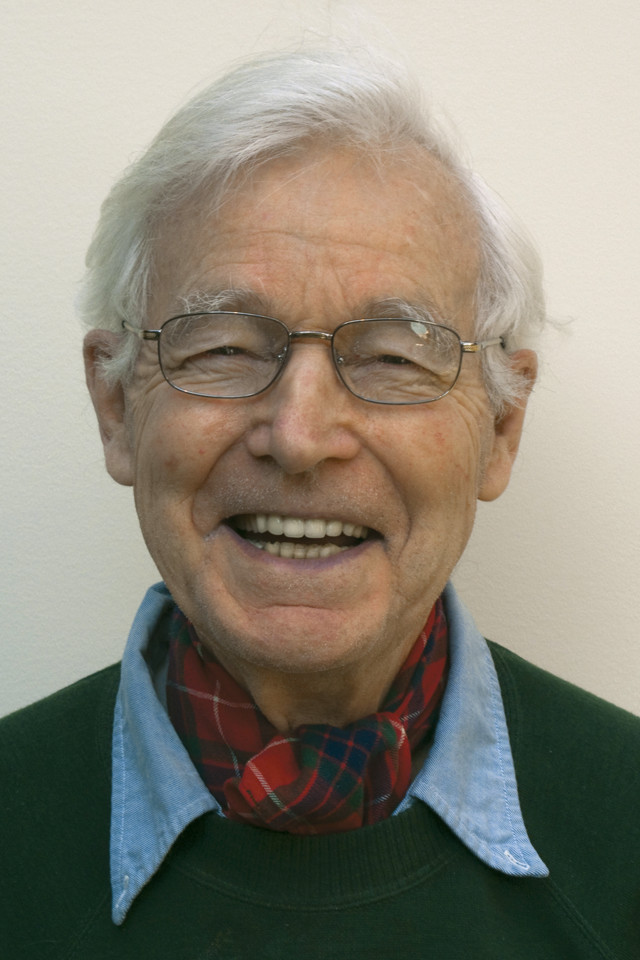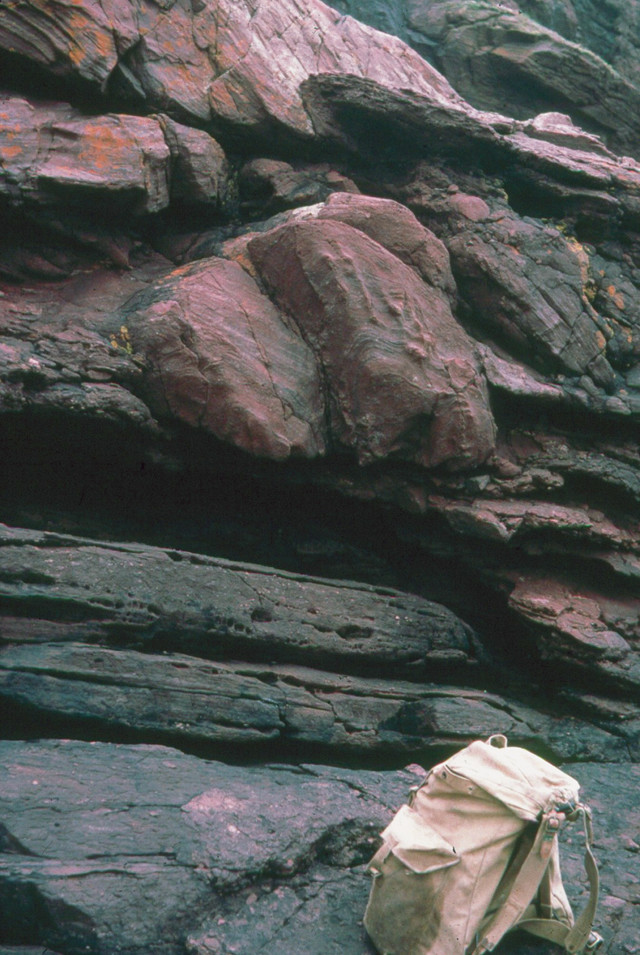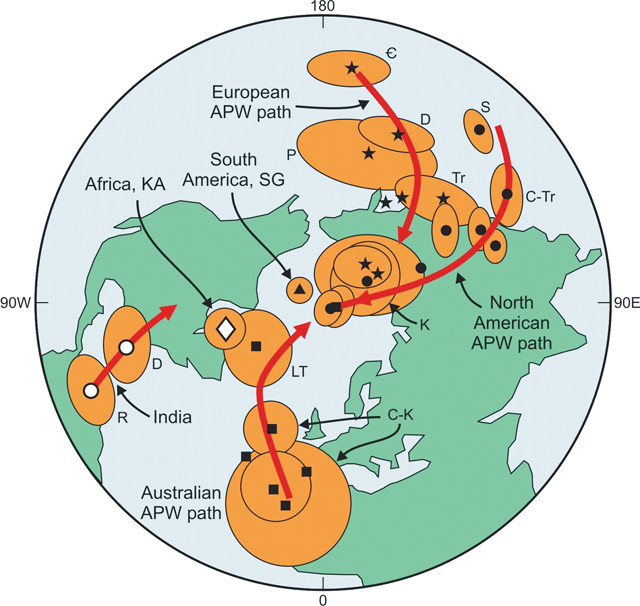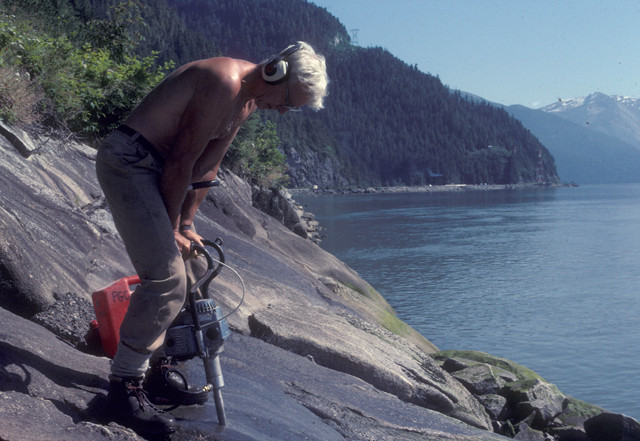
by Nate Burgess Wednesday, May 23, 2018

Ted Irving. Credit: Courtesy of Ted Irving
Geoscience students today may take plate tectonics for granted, but the concept that Earth has a mobile crust has only been generally accepted for the past 40 years. This modern concept is due in part to the work of Ted Irving, a geologist and scientist emeritus with the Geological Survey of Canada. In the 1950s, Irving was one of the first scientists to perform a physical test of — and find hard evidence for — Alfred Wegener’s 1912 hypothesis of continental drift. Continental drift was a precursor to plate tectonics theory, which describes how Earth’s surface is not a single shell, but is divided into large plates that are constantly moving past each other.
Irving was born in the hill country of northern England. After serving in the British army in the Middle East from 1945 to 1948, Irving obtained degrees in geology from Cambridge University and then spent his career working on the geology of the British Isles, Australia and Canada. In addition to helping establish the theory of plate tectonics, Irving also helped lay the foundation for the field of paleomagnetism (using the magnetic signatures of rocks to determine continents’ past locations and orientations) and has received numerous awards.
Today, Irving lives on Vancouver Island, British Columbia, and enjoys visits from his children and grandchildren. EARTH’s Nate Burgess recently spoke with Irving about his life, career and contribution to our modern understanding of how Earth’s crust moves.
NB: When did you first learn about Wegener’s idea of continental drift and what did you think about it?
TI: I had very good lessons in physical geography from a [grammar school] teacher. She actually gave lessons on continental drift and isostasy [the balance of forces tending to elevate and depress Earth’s crust]. I asked her about this, and she said that it was not specifically in the curriculum but she said she was interested in it.
NB: So you learned about continental drift in grammar school, but it still wasn’t a mainstream idea by the time you attended university?
TI: In some universities it wasn’t taught at all, because it wasn’t thought to be correct. But the education I had was really quite liberal. We had a good reading list as geology undergraduates at Cambridge, and there were four books on the list that remained with me. One was the 1922 edition (English translation) of the “Origins of Continents and Oceans” by Alfred Wegener. Another was a book called “The Evolution of Climates through the Ages,” by Wladimir Köppen and Wegener. This book was in German, and I didn’t read German, so I looked at the pictures, which were very clear. The third book was “The Structure of Asia” by Emile Argand. He was the person who put the tectonic side to Wegener’s hypothesis. The last book was Alex du Toit’s “Our Wandering Continents.” So I had a very good foundation in the idea of continental drift.

Irving did his doctoral thesis on this Precambrian conglomerate in northwestern Scotland. In one of the first tests of paleomagnetism, he used magnetic minerals in the rock to determine how Earth's geomagnetic field changed over hundreds of millions of years. Credit: Courtesy of Ted Irving
NB: Your initial attempt at your doctorate at Cambridge was rejected. What happened?
TI: Yes, it has become a bit of a story. My Ph.D. thesis was largely a descriptive work. It was the largest descriptive work done in paleomagnetism at the time on a particular rock unit. The unit was very thick, five kilometers. In my thesis, I didn’t do the usual things that Ph.D. students seem to do — going on about other people’s work, proving how clever they are and how much they had read. My thesis bibliography was really quite small. Because what I was doing was quite new, there were a limited number of geology papers on the subject, and no papers on the paleomagnetism of the Torridonian sandstone [in Scotland] to reference. Therefore, it was really a thesis about new results.
I completely misread the situation. You see, I used to think examiners knew everything about the subject and the historical context and were much more clever than you [laughs], and really, of course, many examinees getting Ph.D.s are examined on subjects about which the examiners really don’t know a great deal. In my case, the examiners had not read the earlier paleomagnetic work nor understood the historical background. So although it was a very publishable piece of work, it was considered an inadequate thesis. It was published verbatim years later, but it was not in the usual mold of a Ph.D. thesis.
The point is, I got a job in Australia [Australia National University], and I knew exactly how to test continental drift. I wasn’t hanging around in England [laughs]. I just put my thesis together very swiftly and caught the first boat. There was no time to be lost, because other people were thinking about the same thing as well. The thesis rejection didn’t really bother me personally. Well, I was upset, but some friends and I went and got drunk, and then it was all right.

This map shows how scientists, including Irving, tested Alfred Wegner's idea of continental drift in the 1950s. The red lines are the paths of motion of the pole relative to various continents. The paths were constructed from paleomagnetic data from Europe (stars), North America (dots) and Australia (solid squares). Credit: Courtesy of Ted Irving
NB: How did you get into paleomagnetism?
TI: In my last year [of undergraduate study at Cambridge], I didn’t do very well. I left Cambridge and was applying for jobs, when in June 1951, I got a letter from S.K. Runcorn of the Cambridge Department of Geodesy and Geophysics. He had become interested in paleomagnetism because he wanted to look at the very old secular change in Earth’s magnetic field — that is, changes occurring in Earth’s field over hundreds of years — because such phenomena were only the longer-term ones that were well-established at that time. Such work was possible because [physicist] P.M.S. Blackett in the United Kingdom had just built a very sensitive magnetometer for measuring the very weak magnetization of rocks.
My recruitment was actually a matter of luck, as I didn’t know Runcorn. Runcorn, a physicist, needed geological help collecting samples. It so happened that Runcorn played rugby football with a friend of mine, and was complaining over drinks one day about how he was having difficulty finding geological help. My friend gave him my name, and so I got this letter out of the blue for this strange and esoteric purpose.
NB: And how did you realize paleomagnetic research could help prove continental drift?
TI: My interest in continental drift was already formed from reading those books as an undergraduate.
At that time, there was pioneering work being done by Jan Hospers — specifically in finding reversals of magnetization in stratigraphic sequences, and in establishing that Earth’s magnetic field, when averaged over thousands of years, was roughly that of an axial geocentric dipole, or a magnet at the center of the Earth directed along the axis of rotation.
I knew from my knowledge of continental drift that the continent that had moved the most in a latitudinal sense was India, and Hospers’ work suggested that we could, in principle, measure latitude paleomagnetically. I managed to get my hands on samples from the Deccan Traps — massive volcanics on the west side of India. I was able to show the samples probably originated in the Southern Hemisphere, though I only had seven localities. So my direct involvement in continental drift really began in late 1951 or early 1952, when I wrote to the head of the geological survey in India to obtain those rocks, and the results were published in my thesis.
NB: So was that the moment that people look back on as the first physical proof of continental drift?
TI: No, no, no, only my personal epiphany. Continental drift was such an immense problem that you weren’t likely to prove it in a Ph.D.
NB: You were also looking at ancient environments, and comparing them to what you were predicting with your paleomagnetic latitudes?
TI: Yes. If our procedures were correct, then the latitudes that we would get [paleomagnetically] would have to agree with the latitudes that were determined geologically, from paleoclimatic evidence in the same region. Also, if you had a set of results, say from Europe, you could calculate what the latitudes of any other place in the world ought to be. If continents had remained fixed, then the paleoclimatic evidence should agree with these calculations. They did not, and by the late 1950s, we knew this to be correct globally, which is precisely what continental drift required. It took some time for this to become accepted.

Irving drilling samples by the side of the Skeena River in northern British Columbia around 1980. Credit: Courtesy of Ted Irving
NB: It is interesting that all this work was descriptive, rather than concerning a mechanism, especially since Wegener’s original hypothesis was panned because he came up with a mechanism and people disagreed with it.
TI: It is interesting you should ask this, because it’s something I’ve lived with for a long time. The earth sciences can really be divided into two realms, two solitudes almost: the short term and the long term. And the current tendency is for most funding to go to the short term: to earthquake prediction and these kinds of things. Seismology, that’s something that is primarily concerned with a mechanism, with process — just as Wegener, being a meteorologist, was concerned with mechanism, with cloud formation. But then when he started looking at history, the other side of geology, he was dealing not with process or mechanism but with history — in the sense that the best he could ever achieve is a description of what happened. There could be hypotheses about cause, but never anything final.
Most of geophysics deals with the short term and belongs on the process side. And then all of a sudden we extended into the historical realm. It was not as if other people hadn’t done that before, but we did it in a systematic way and globally, and this immediately transformed the subject of geomagnetism from something that was mechanism-oriented to something that was substantially historically based.
I think this leads to one of the crucial errors I see in general discussions of this sort — the idea of plate tectonics being a mechanism. It’s just not.
Wegener, in retrospect very unwisely, jumped ahead — because he was vaulting from the realm of mechanism to the realm of history. He left himself vulnerable; his mechanisms were quickly disproved, discrediting his entire idea.
NB: How close do you think we are to coming up with a full-fledged mechanism?
TI: I don’t make predictions any longer, being on the wrong side of 80 [years]. But I suspect we shall never know. You see physics is a subject that doesn’t really have this problem of history. By and large, it doesn’t have this division of subject. But all the historical subjects — biology and geology in particular — do. And we are left really only with the expectation that there will always be problems with any mechanism the human mind can come up with because we can never go down to the middle of the Earth and watch it. We can only [observe] it by indirect means. And to wishfully think otherwise seems to misunderstand the nature of our work. Mechanism is something that can really only be elucidated for the here and now, not a hundred million years ago.
NB: What advice do you have for geoscientists starting their careers today?
TI: One of my supervisors [at Cambridge] was really quite outstanding: Gertrude (Gertie) Elles. She was a prominent geologist in the early 20th century. She asked me one day, “What are you reading, Irving?” And I told her what I was reading — primarily books. And she said to me, “Books? Stop reading books! Read originals, because then you know what people actually said.” And her words have rung through my mind ever since — the importance of getting the source of material instead of getting things secondhand or thirdhand. So I would pass on Gertie’s advice to students.
© 2008-2021. All rights reserved. Any copying, redistribution or retransmission of any of the contents of this service without the expressed written permission of the American Geosciences Institute is expressly prohibited. Click here for all copyright requests.